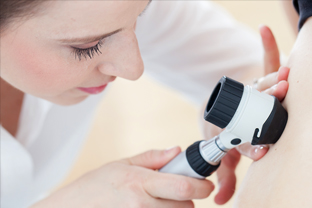 You've probably read a few stories about melanoma, the deadliest skin cancer, but you may not have read much about two far more common skin cancers.
You've probably read a few stories about melanoma, the deadliest skin cancer, but you may not have read much about two far more common skin cancers.
Basal and squamous cell skin cancers (or carcinomas) are the most prevalent types of skin cancer. They start in the top layer of skin and are usually caused by sun exposure.
Basal cell carcinomas
These skin cancers make up about eight out of 10 skin cancer diagnoses. They usually develop on sun-exposed areas of the body—often the face, head or neck.
Basal cell carcinomas usually grow slowly. Rarely do they spread to other parts of the body. But if not treated, a basal cell carcinoma can invade bone or other tissues beneath the skin.
Squamous cell carcinomas
About two out of 10 skin cancers are squamous cell carcinomas. Like basal cell cancers, squamous cell carcinomas appear on sun-exposed parts of the body, including the face, ears, neck, lips and backs of the hands.
Squamous cell cancers are more likely than basal cell carcinomas to spread to other parts of the body.
What do these cancers look like?
Skin cancer looks like an abnormal area of skin. It can be:
• Pink.
• Red and swollen.
• Peeling.
• Bleeding or looking like an open sore.
• Thick or crusty.
It's important to remember that not all skin changes are cancer, but it's best to show your healthcare provider any changes to your skin that you think might be abnormal.
Risk factors
As mentioned before, the biggest risk factor for basal and squamous skin cancers is exposure to ultraviolet (UV) rays of the sun. Tanning beds also use UV rays. That's why tanning beds are not a safe alternative to sun tanning.
Other risk factors include:
• Having fair skin. People who have light-colored skin that freckles or burns easily, blue or green eyes, and naturally red or blonde hair are at especially high risk.
• Being male.
• Being older. The risk of both cancers goes up with age.
• Having been previously diagnosed with either basal or squamous cell skin cancer.
• Smoking also has been linked to an increased risk of squamous cell skin cancer.
Treatment options
Different types of surgery are often used to treat both basal and squamous cell cancers, depending on the size and locations of the tumor.
Other possible treatments for these cancers include:
• Radiation therapy. This if often a good option for patients who can't have surgery and for tumors that are on areas that are hard to treat surgically, such as the eyelids, nose or ears.
• Skin creams that can kill cancer cells.
• Photodynamic therapy. A doctor uses a special light and special cream to destroy the cancer.
After treatment your skin will have to be checked regularly to be sure the cancer doesn't return. Both you and your healthcare provider can keep checking your skin to look for any new changes.
To schedule an appointment with one of our board-certified Dermatologists, please
visit our website.
Sources: American Cancer Society; UpToDate